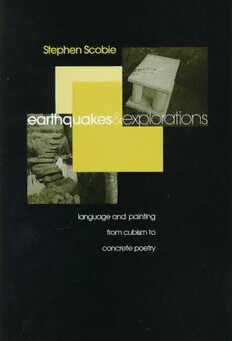
Earthquakes and Explorations: Language and Painting from Cubism to Concrete Poetry PDF
Preview Earthquakes and Explorations: Language and Painting from Cubism to Concrete Poetry
EARTHQUAKES AND EXPLORATIONS: LANGUAGE AND PAINTING FROM CUBISM TO CONCRETE POETRY THEORY /CULTURE Editors: Linda Hutcheon, Gary Leonard, Jill Matus, Janet Paterson, and Paul Perron STEPHEN SCOBIE Earthquakes and Explorations: Language and Painting from Cubism to Concrete Poetry UNIVERSITY OF TORONTO PRESS Toronto Buffalo London © University of Toronto Press Incorporated 1997 Toronto Buffalo London Printed in Canada ISBN 0-8020-4141-8 Printed on acid-free paper Canadian Cataloguing in Publication Data Scobie, Stephen, 1943- Earthquakes and explorations : language and painting from cubism to concrete poetry (Theory / culture) Includes bibliographical references and index. ISBN 0-8020-4141-8 1. Cubism and literature. 2. Art and literature. 3. Painting, Modern - 20th century. 4. Concrete poetry - History and criticism. I. Title. II. Series. PN53.S36 1997 759.0632 C97-930955-7 The illustrations in chapter 9 are reproduced with the permission of Ian Hamilton Finlay. Figures 3-7 are taken from Yves Abrioux, Ian Hamilton Finlay: A Visual Primer (Edinburgh: Reaktion Books 1985). Lyrics from Bob Dylan's 'Visions of Johanna/ page 22: Copyright © 1966 by Dwarf Music. All rights reserved. International copyright secured. Reprinted by permission. This book has been published with the help of a grant from the Humanities and Social Sciences Federation of Canada, using funds provided by the Social Sciences and Humanities Research Council of Canada. University of Toronto Press acknowledges the financial assistance to its publishing program of the Canada Council for the Arts and the Ontario Arts Council. As the other guests had not yet come Miss Stein took me into the atelier. It often rained in Paris and it was always difficult to go from the little pavilion to the atelier door in evening clothes, but you were not to mind such things as the hosts and most of the guests did not. We went into the atelier which opened with a yale key the only yale key in the quarter at that time, and this was not so much for safety, because in those days the pictures had no value, but because the key was small and could go into a purse instead of being enormous as french keys were. Against the walls were several pieces of large italian renaissance furniture and in the middle of the room was a big renais- sance table, on it a lovely inkstand, and at one end of it note-books neatly arranged, the kind of note-books french children use, with pictures of earthquakes and explorations on the outside of them. And on the walls right up to the ceiling were pictures ... Gertrude Stein, The Autobiography of Alice B. Toklas This page intentionally left blank Contents PREFACE IX ACKNOWLEDGMENTS xiii CHAPTER ONE The Supplement of Language 3 CHAPTER TWO 'We Are a Man': The Narrativization of Painting 22 CHAPTER THREE Apollinaire and the Naming of Cubism 35 CHAPTER FOUR The Gospel According to Kahnweiler 57 CHAPTER FIVE The Semiotics of Cubism 79 CHAPTER SIX Metaphor and Metonymy in Cubism and Gertrude Stein 104 CHAPTER SEVEN The Window Frame: Delaunay and Apollinaire 124 ENTR'ACTE Signs of the Times 145 viii Contents CHAPTER EIGHT Gadji Beri Bimba: Abstraction in Poetry 153 CHAPTER NINE Models of Order: Ian Hamilton Finlay 169 NOTES 195 WORKS CITED 219 INDEX 229 Preface I remember when this book first began for me: it was on Pentecost (the feast of the gift of tongues) in 1974, and it was in Paris. Maureen and I were sitting at a cafe on the Boulevard St Germain. I had just come from an exhibition at the Orangerie of paintings by Juan Gris, which I had gone to because of the connection between Gris and the Scottish poet Ian Hamilton Finlay. Finlay has created several poems in tribute to Gris, and he had often spoken to me of the importance in his early work of the massive study of Gris by Daniel-Henry Kahnweiler, the Cubist painters' most important dealer and theoretician. The earliest premise on which this book was based, then, was that of the connection between Cubism and Concrete Poetry.1 Sitting at that cafe, I began jotting down names on a piece of orange paper - Gris, Finlay, Gertrude Stein, bpNichol - and drawing connec- tions between them - a maze of arrows, broken lines, question marks, overlapping grids. Over the years, as I have tried on several occasions to write this book, much has changed in my own ideas and assump- tions about both poetry and painting, but the basic configuration of that first diagram has remained as its ground plan. As it has now emerged, this book has a double focus. On the one hand, there is a broad theoretical concern with the interaction between painting and poetry, between the visual and the verbal. I want to argue that this relation should not be seen as one of division or opposition, but rather as one of mutual implication and interpenetration. In trying to describe this interaction, I will evoke the notions of the supplement and the frame (parergon), as these ideas have been developed by Jacques Derrida. This relation is grounded, I will argue, in the pervasiveness of language (in its broadest sense), and in the ways in which language
